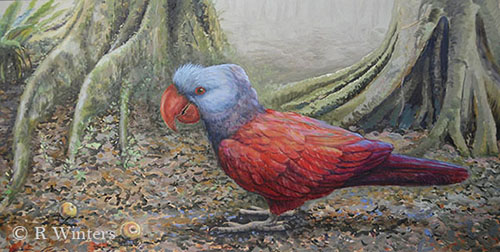
Bird lovers know the Indian Ocean island of Mauritius mostly because of its famous inhabitant, the Dodo (Raphus cucullatus). This giant flightless pigeon died out in the late seventeen hundreds, in less than a century after man set foot on the island. The Dodo was subject of paintings, animated movies and many publications. It became famous as the odd, fat pigeon with the enormous beak, and also as the icon of extinction.
Besides the Dodo Mauritius was inhabited by many other birds and animals that were unique to the island. One of them was a huge, ground dwelling parrot. The Dutch who first saw it in 1598 named it the Indian raven, in reference to its raucous raven-like call.
History left us a beautiful drawing of this species. The journal of the ship the Gelderland – one of the five Dutch east Indiamen that stayed for a month on Mauritius in 1601 – was not just a navigational diary; it was illustrated with several depictions of the local wildlife. It gave us a detailed drawing of a pair of those birds, that were later named Broad-billed parrots (Lophopsittacus Mauritianus). The sketch was in black and white, so unfortunately it did not show the colour of its feathers, beak and legs.
Several modern artists have depicted this parrot and mostly gave it a dark coloration. Very likely this was done because of the name it had been given initially of Indian raven, overlooking the fact that the name was in reference of its call instead of its colour. However, there were some clues that the Broad-billed parrot had more than one shade. One of them came from J.C. Hoffman, a German preacher serving in the Dutch community on Mauritius from 1673-1675, who spoke of “ravens with blue heads and red recurved beaks”.
Recently an unpublished manuscript has been discovered in the National Archives in The Hague with the description of the nature of Mauritius. It was written by Johannes Pretorius, an employee of the Dutch East India Company, who stayed on Mauritius from 1666 to 1669. Pretorius kept a number of endemic birds in captivity, which was probably an experiment to ascertain their captive requirements prior to transportation. He provided the first ecological details of some of the now-extinct birds, like the Broad-billed parrot. From his description we now know that this parrot had beautiful colourings. His description of the bird was as follows: “the Indian ravens are very beautifully coloured. They cannot fly and are not often found. This kind is a very bad tempered bird. When captive it refuses to eat. It would prefer to die rather than to live in captivity”.
The discovery of the manuscript led to the publication of a scientific paper in ‘Historical Biology: an international Journal of Paleobiology’ in April 2015 (written by artist and paleontologist Julian P. Hume and myself). In this paper we reinterpreted the colour of the Broad-billed parrot to be bright, being predominantly red with a blue head. Its probable relationship with SE Asian parrots suggest that the bill was similarly red. Like other Mascarene parrots it may have also exhibited iridescence or gloss that changed with the angle of light. I tried to convey this with my oil painting, depicted above.
This truly remarkable parrot inhabited the forest floor of the undisturbed Mascarene forest. After seventy years of human occupation it had become rare. Hoffman’s account in 1673-1675 was the last record. It probably died out soon after that.
Further reading and more illustrations are on http://www.tandfonline.com/doi/pdf/10.1080/08912963.2015.1036750
“Captive birds on Dutch Mauritius: bad-tempered parrots, warty pigeons and notes on other native animals”, by Julian P. Hume and Ria Winters.
































